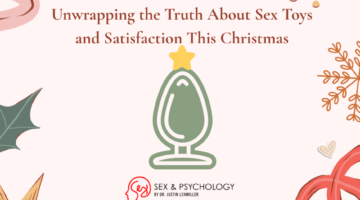Why Do We Kiss Under Mistletoe?
December 25, 2017 by Justin Lehmiller

Many of us decorate with mistletoe around the Christmas holiday. It’s often hung from the ceiling or over a door, with kisses offered to those who stand under it. Have you ever wondered why, though? How did mistletoe come to be associated with kissing anyway? Here’s a look at what we know, along with some other interesting trivia about what is widely considered to be the sexiest and most romantic Christmas symbol.
The first thing you should know is that mistletoe is actually a parasitic plant. This means it’s not something you’d actually want to find growing in your own back yard! Mistletoe penetrates the branches of a tree, giving it the ability to steal nutrients and water. This lets the mistletoe grow and thrive, while the host tree suffers.
Mistletoe is a species of phoradendron, a name that literally means “tree thief” or “thief of the tree” in Greek, reflecting its parasitic nature. In light of this, it kind of makes sense that, as a holiday decoration, this theme of thievery has carried over, with mistletoe being used as an excuse to “steal” kisses (though let’s be clear that it’s not truly stealing, given that people standing under the mistletoe obviously have the right of refusal).
That said, this thievery connotation isn’t why mistletoe came to be linked to kissing. It probably has more to do with the fact that mistletoe has long been seen as a fertility symbol. This is because mistletoe can grow just about anywhere. For example, some species grow in the desert, whereas others thrive in the dead of winter. This plant’s ability to thrive even in the harshest conditions is why mistletoe was historically used as a treatment for infertility in humans and animals alike in many cultures.
In addition to being a symbol of fertility, it’s also worth pointing out that mistletoe played a pivotal role in ancient Norse folklore, in which the gods declared this plant to be a symbol of love and life.
As you can see, mistletoe went from being a sacred plant that promotes health and fertility to a holiday decoration that inspires kissing. When exactly the holiday tradition began is unclear, but now that you have some sense of the history of mistletoe’s symbolism, the fact that this plant gets put on display every December probably makes a little more sense.
Here’s another interesting piece of mistletoe trivia to tie it in with science: in modern times, mistletoe isn’t just used as an excuse for kissing—it continues to be used as a medicinal plant in some parts of the world. In fact, in some European countries, mistletoe extract is one of the most common medicines prescribed to cancer patients! Despite its popularity in Europe and some research suggesting that mistletoe can kill cancer cells, it is not FDA approved for use in the United States (learn more about mistletoe as a cancer treatment here).
Happy Holidays!
Want to learn more about Sex and Psychology? Click here for previous articles or follow the blog on Facebook (facebook.com/psychologyofsex), Twitter (@JustinLehmiller), or Reddit (reddit.com/r/psychologyofsex) to receive updates.
Image Source: 123RF.com/Anna Bizon
You Might Also Like:

Dr. Justin Lehmiller
Founder & Owner of Sex and PsychologyDr. Justin Lehmiller is a social psychologist and Research Fellow at The Kinsey Institute. He runs the Sex and Psychology blog and podcast and is author of the popular book Tell Me What You Want. Dr. Lehmiller is an award-winning educator, and a prolific researcher who has published more than 50 academic works.
Read full bio >

